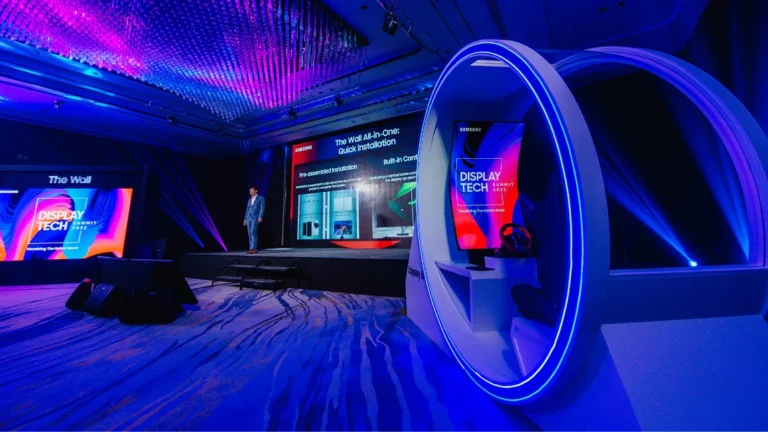Innovations like foldable Display Technology screens, micro-LEDs, and augmented reality interfaces shape display technology’s future. Trends include ultra-high resolution, flexible displays, and eco-friendly materials. These advancements promise enhanced visual experiences, versatile applications in devices, and sustainability, paving the way for the next generation of immersive and efficient display solutions.
Introduction to Display Technology
Table Of Contents
Display technology has come a long way since the days of bulky cathode ray tube (CRT) monitors. Today, we enjoy slim, high-resolution digital displays with rich colors and deep contrasts. This progression is no small feat; it’s driven by constant innovation and consumer demand for better visual experiences. With advancements in hardware and software, these modern displays are more than just screens—they’re windows into new worlds, facilitating everything from entertainment to education and daily productivity.
The quest for superior display technologies has spurred the innovation of OLED and microLED screens, providing users unparalleled image quality. This article delves into these advances and explores future trends that promise to transform our visual experiences. As our reliance on digital displays grows, understanding these innovations and their implications can help consumers and businesses make informed decisions.
The Rise of OLED and MicroLED
MicroLEDs and organic light-emitting diodes (OLEDs) are at the forefront of display innovation. These technologies offer significant advantages over traditional LCD screens. OLED displays are renowned for their excellent color accuracy and deep black levels, achieved by individually lighting each pixel. This individual pixel control allows for true blacks and vivid colors, enhancing the viewing experience. OLED screens have become the go-to choice for high-end televisions, smartphones, and even some laptops, providing visuals that are both stunning and true to life.
MicroLED displays, on the other hand, bring brightness and efficiency to a new level. Unlike OLEDs, micro LEDs use inorganic materials, which provide excellent durability and a longer lifespan. This technology is ideal for various applications, from tiny displays in smartwatches to massive public display screens. Its efficiency means it consumes less power, making it both cost-effective and environmentally friendly. According to TechRadar, OLED and microLED technologies are revolutionizing our viewing experience by offering unprecedented brightness, contrast, and energy efficiency.
Eco-Friendly and Energy-Efficient Displays
The display sector is focused on sustainability as environmental problems gain global attention. Energy-efficient technologies are being integrated into displays to reduce power consumption. For instance, manufacturers adopt low-power consumption backlights and optimize power management systems within the screens. Additionally, some displays now incorporate solar energy elements or are designed to work with renewable energy sources, significantly reducing their carbon footprint.
In addition to power efficiency, using recyclable materials is gaining traction. Companies are increasingly focusing on developing screens that use eco-friendly materials, which are easier to recycle and less environmentally harmful. These initiatives are crucial as electronic waste becomes a growing concern globally. Backed by innovations in green technology, displays today are about the visual experience and contributing to a sustainable future. The merging of display technology with green energy solutions exemplifies how the industry strives to balance performance and environmental stewardship.
Smart Displays and Interactivity
Smart displays are becoming increasingly popular, transforming how we interact with technology. These displays integrate seamlessly with various smart home devices and services, offering functionalities beyond simple viewing. Features like voice control, touch interactivity, and seamless connectivity have turned displays into versatile hubs for home and business environments. For instance, an intelligent display in the kitchen can show recipes, control smart appliances, stream music, and even handle video calls, providing multifaceted utility in a single device.
For businesses, the versatility of intelligent displays is invaluable. Interactive kiosks and digital signage equipped with innovative technology can uniquely engage customers. Retailers can use these displays to offer personalized shopping experiences, while educational institutions can employ them for interactive learning. The vast and varied business applications emphasize the importance of intelligent, interactive displays in our digital lives. With the integration of AI and IoT (Internet of Things), these displays are set to become even more intelligent, providing customized experiences tailored to individual users’ needs and preferences.
Future Trends in Display Technology
Looking ahead, the display industry is set to see even more advancements. One of the most exciting prospects is the development of foldable and rollable screens. These flexible displays can bend and fold without breaking, opening up new possibilities for mobile devices and larger screens that can be easily stored or transported. Innovations in materials science are making this possible, with companies experimenting with substrates like graphene to achieve unprecedented levels of flexibility and durability.
Another exciting development is the potential for holographic displays. While still in the early stages, holographic technology aims to project three-dimensional images into the space around us, providing a more immersive experience without special glasses. This could revolutionize entertainment, education, and medical imaging, offering a new way to visualize complex data and environments. With ongoing research and investment, these future trends promise to create displays that are not only visually stunning but also highly functional and energy-efficient.
Conclusion
The future of display technology is bright, with rapid advancements that promise to enhance our visual experiences unprecedentedly. Whether through the adoption of OLED and microLED technologies, the push for eco-friendly solutions, or the integration of smart, interactive features, display technology continues evolving remarkably. Keeping up with these trends may help organizations and consumers make smarter decisions and fully use the newest advancements.
